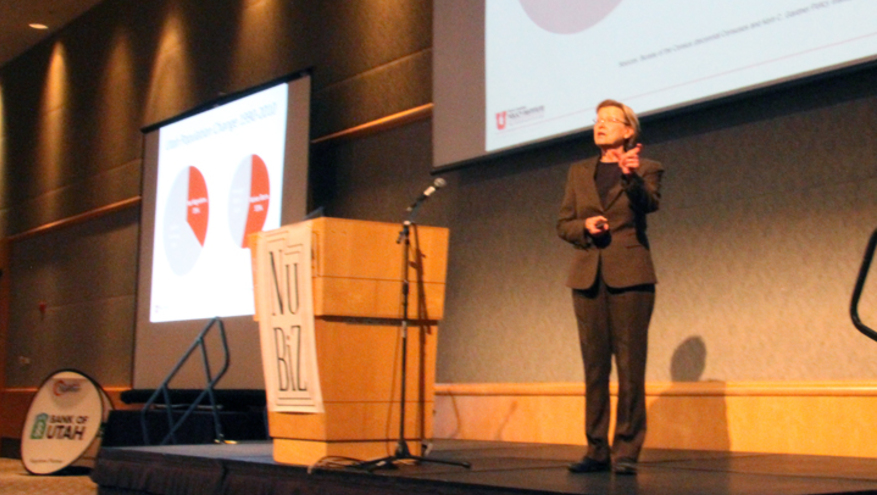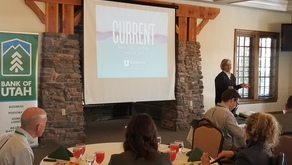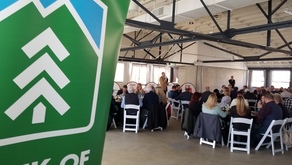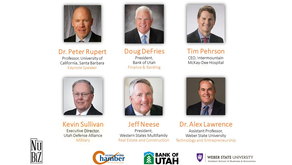What is your description of a typical Utahn? If you guessed that person to be a middle-aged white male with a large family, you may be surprised to know that profile is no longer the norm. Utah’s population is changing and now is the time to make plans, according to Pamela S. Perlich, Ph. D., director of demographic research at University of Utah’s Kem C. Gardner Policy Institute.
Perlich headlined Economic Outlook Events hosted by Bank of Utah in Logan, Ogden, Salt Lake City and Lehi in late February. She revealed new population estimates and projections for those communities and the state, which showed that over the next 50 years Salt Lake City’s greater metropolitan area is trending to become more culturally and ethnically diverse even while the share of elders increases dramatically. Perlich presented trends for population growth, migration, fertility, age and diversity, with the goal to help business and community leaders anticipate growth and foster sound policy to support their communities.
Data trends show Utah will approach six million residents by 2065. Utah County alone will have 1.6 million people in 50 years, just trailing Salt Lake County that will have 1.7 million. Gardner Institute data show that from this sustainable growth we will see the emergence of a global metropolitan area that will stretch from Northern Utah, all the way down to Juab County, much like the Seattle-Tacoma metropolitan area. Tooele, Juab, and Wasatch Counties will also see major growth.
Natural increase (births exceeding deaths) will contribute roughly two thirds of the growth. But migration is expected to be consistently positive and to contribute to the other third. New residents will come for economic and educational opportunities and because of what Perlich called, “Utah’s Sales Force” (world-wide Mormon missionaries). Those who migrate to Utah will be young, motivated people of diverse backgrounds. They in turn will give birth to children, often of mixed heritage, who will grow up in Utah. Data show that half of the people who migrate to Utah today, are from outside of the U.S. Latin Americans are the largest immigrant group currently in Utah. Since the recovery from the Great Recession, Asia has become the major sending region of international people coming to the state, often for education and tech sector job opportunities.
Perlich also reported that married couple households with children are no longer the norm, composing 30 percent of all households. The state actually does not have a “median” family as many different living arrangement configurations are emerging. Even as fertility declines and the population ages, the size of households began to increase from 2010 onward. Today, a mix of related and non-related people are sharing housing facilities. Baby Boomers are moving in with their children, children are moving back to live with their parents and single un-related adults are cohabitating to combat Utah’s low wages, the rising costs of housing and the shortage of available existing homes for sale. This is in line with national housing trends.
According to Perlich, Utah recently relinquished its status as number one in fertility. Now South Dakota has that honor, with Utah coming in second due to a consistent drop in fertility rates. Currently the total fertility rate in Utah is 2.24 per woman.
While Utah remains among the youngest states, it is also experiencing significant growth of the elder population. The share of the population at least 65 years old will increase from its current one-in-ten to one-in-five people in the state in 50 years. However, Millennials already outnumber Baby Boomers as they age into higher mortality years.
“Utah will become fundamentally different,” said Perlich. “Our state is forever changed, and this irreversible globalization of our state will present new challenges.” Even now a recent survey showed that 129 different languages are spoken in Utah homes, and one-in-four preschoolers in Utah today are from a minority population.
“We live in an exciting time, and we need to start planning for Utah’s future,” added Perlich. “Many of our community institutions and businesses were built for the old Utah. As we plan for the future, we need to consider Utah’s new reality and economy.”
Bank of Utah President Douglas L DeFries said, “We sponsor the Economic Outlook Events every year to provide our bank customers and friends with valuable information in a condensed and accessible format that will help them make plans for the year. We’re very grateful to Dr. Perlich and The Kem C. Gardner Policy Institute for partnering with us and providing such eye-opening information about Utah’s future.”
You can view the presentation from each event at the links below:
Weber County Focus
(Dr. Perlich's presentation with additional presentations from James Taggart, OWATC and Eric Allen, MetroStudy)




